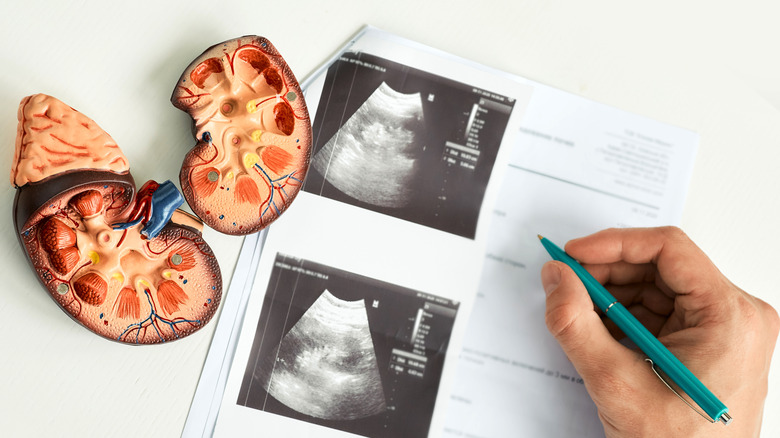What Is Hydronephrosis And What Causes It?
Hydronephrosis is the swelling of the kidneys due to a backup of urine in the urinary tract that hasn't sufficiently drained (via the Mayo Clinic). The condition is categorized into 2 types depending on how many kidneys are affected (via the Cleveland Clinic). In a case where only one kidney is impacted, it is referred to as unilateral hydronephrosis. When both kidneys are affected, it's known as bilateral hydronephrosis. While anyone can develop the condition, hydronephrosis is known to affect 1 in 100 babies (via Boston Children's Hospital) and can be the result of anatomic abnormalities, according to the Cleveland Clinic.
While some people with hydronephrosis do not experience any symptoms, flank pain — pain along one's sides or back — is among the most common symptoms, along with groin or abdominal pain (via the National Kidney Foundation). Vomiting, nausea, fever, blood in the urine, or frequent urination are also possible symptoms (via the Cleveland Clinic), though symptoms may vary depending on the cause of the blockage. What exactly causes hydronephrosis and what are the risks associated with the condition?
Hydronephrosis is often the result of an alternate medical condition
According to Urology Associates, hydronephrosis is most often a symptom of an alternate condition, such as a urinary tract infection (UTI), blood clot, enlarged prostate, tissue scarring, or a preexisting blockage from birth. In younger adults, hydronephrosis is often caused by kidney stones (via the Cleveland Clinic). Additionally, one particular condition commonly associated with hydronephrosis is vesicoureteral reflux, in which urine flows in the opposite direction through the ureters (via Kids Health). Depending on whether or not the condition is primary or secondary, it may be a result of genetics or an obstruction from damage or infection.
Your doctor can conduct a number of tests in order to formally diagnose the condition including blood tests, urine tests, imaging scans, and physical examinations that sometimes include the rectum or pelvis (via the Cleveland Clinic). Depending on the cause and severity of the case, hydronephrosis may be treated with antibiotics, catheter drainage of the bladder, or surgical removal of the blockage (via Urology Associates). Oftentimes, however, hydronephrosis heals on its own (via the Mayo Clinic). Nonetheless, be sure to consult with your doctor. Untreated hydronephrosis can impact kidney function and may result in permanent kidney damage.


